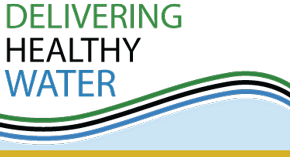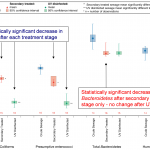Regulation and Policy
Download the Regulation, Policy and Science Briefing Paper
The quality of UK bathing waters is assessed by enumerating bacteria known as faecal indicator organisms (FIOs) throughout the bathing season. Waters used to harvest shellfish are monitored for FIOs as well. E.coli is a common FIO derived from the gut of warm blooded animals and is harmless, but its detection in environmental samples or shellfish flesh indicates the potential for the presence of disease causing microbes derived from faecal material. Their detection at designated bathing and shellfish harvesting waters at levels above standards specified within EU directives can lead to beach closures or shellfish stocks being classed as unfit for human consumption and can therefore have serious implications for local economies and social activity as well as human health.
In 2012only 403 of the 754 of UK bathing beaches were recommended by the Marine Conservation Society (MCS) for excellent water quality. That is 113 fewer beaches than were recommended in 2011.Over the past 5 years, since a peak in the number of MCS recommended beaches in 2006 and 2007, water quality has declined. Today, poor water quality is often linked with heavy rainfall and recent wetter summers have made this type of pollution worse. MCS is concerned that the current situation may further deteriorate when new stricter bathing water standards are introduced in 2015 under the revised Bathing Water Directive. Under this new regime approximately 14% of Britains beaches are at risk of failing the new minimum water quality standard if nothing is done to improve them
The pressure for rapid methods development in the United States was, in part, driven by a legal judgment against the USEPA which had not revised its recreational water quality guidelines within an agreed timescale. This pressure is also seen in other parts of the world where the principal driver is the implementation of near-real-time assessment and/or prediction of bathing water quality to underpin advisory notices to the user community as a practical means of public health protection. This approach was recommended by WHO (2003) and is founded on the delivery of informed choice to the bathing water user community as the most appropriate tool in public health protection where elevation in the environmental risk can change in hours or minutes which are not reflected in normal environmental monitoring with sampling frequencies measured in weeks or months. The EU Bathing Water Directive (2006), which will be implemented in 2015, enshrines this concept of real-time prediction and public information on likely elevations in health risk indexed by microbial indicator species.
Whether public advisory notices are best driven by a single early morning sample analysed by a rapid method, such as qPCR, or by predictive modeling, as currently used in Scotland (Stidsonet al, 2012) is still the subject of several research investigations in the UK and world-wide (see for example:- http://www.smartcoasts.eu/team/team.asp).
However, the push towards molecular methods for regulatory compliance assessment by a leading science-led nation such as the USA raises many questions for other nations and continents with very similar policy frameworks for water regulation such as the UK and the EU (Kay et al., 2012; Oliver et al., 2012). No single microbial enumeration approach offers a silver bullet for the policy community. For example, one problem with the use of qPCR in environmental waters is that the qPCR signal is not attenuated by commonly used effluent disinfection approaches such as UV irradiance which has a dramatic impact on the viability pathogens and indicators. This reduction in risk is measured by culture methods but not by the molecular qPCR assay. This is illustrated in Figure 1 which shows the attenuation of the common faecal indicators, measured by culture, and Bacteriodetes spp., measured by qPCR, across the most common treatment train for UK sewage effluents before sea disposal (Stapleton et al., 2009). Other EU-wide studies have suggested potential analytical problems with the precision and inter-laboratory reproducibility of qPCR-based enumeration which could detract from their utility as a regulatory tool with clear legal implications (see for example:-http://www.virobathe.org/)
Figure 1 Attenuation of faecal indicator organisms measured by culture methods (coliform and enterococci) compared to Bacteriodetes measured by qPCR as a typical UK sewage treatment works, note the different vresponse to UV disinfection of the culture-based and molecular-based assay results. (Source: Stapleton et al., 2009)
Thus, the UK and EU science and policy communities are facing interesting and difficult challenges in deciding on appropriate microbial methods and parameters for future regulation. Delivering Healthy Water, addresses this challenge to inform both communities on the current status of this knowledge-base and it charts the potential decisions and options available.
The first international workshop held in London on March x 2012 brought together a group of experts from the UK, EU and USA to discuss the benefits and limitations of qPCR and explore the hopes, needs and concerns of the policy, regulatory and stakeholder communities.
A briefing paper containing the major findings and recommendations in relation to the science, regulation and policy fields is available to download HERE
References
Kay. D., Crowther, J., Davies, C., Edwards, A., Fewtrell, L., Francis, C., Kay, C., McDonald, A., Stapleton, C., Watkins, J. and Wyer, M. (2012) Impacts of agriculture on water-borne pathogens.In Hester, R.E. and Harrison, R.M. (Eds) Impacts of agriculture on water-borne pathogens.Issues in Environmental Science and Technology Series, Volume 34, Royal Society of Chemistry. London. (in press).
Oliver, D. M., Heathwaite, A. L., and Haygarth, P. M. (2010).A culture change in catchment microbiology? Hydrological Processes 24, 2973-976.
Stapleton, C.M., Kay, D., Wyer, M.D., Davies, C., Watkins, J., Kay, C., McDonald, A.T., Porter, J., Gawler, A. (2009) Evaluating the operational utility of a bacteroidales quantitative PCR-based MST approach in determining the source of faecal indicator organisms at a UK bathing water. Water Research 43, 4888-4899. (DOI:10.1016/j.watres.2009.09.015).
Stidson, R.T., Gray, C.A. and McPhail, C.D. (2012) Development and use of modelling techniques for real-time bathing water quality predictions. Water and Environment Journal. DOI:Â 10.1111/j.1747-6593.2011.00258.x (in press)
WHO (2003) Guidelines for safe Recreational Water Environments. Volume 1 Coastal and Fresh Waters. WHO Geneva 253 Pages.


